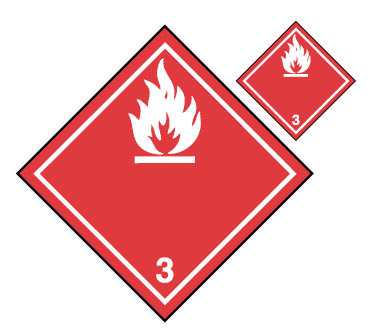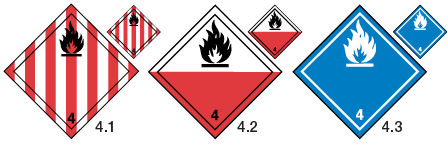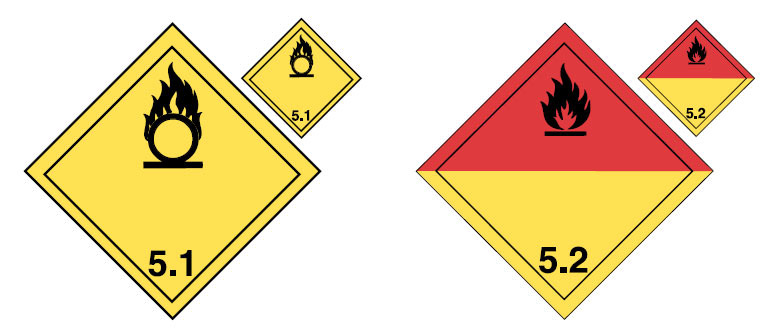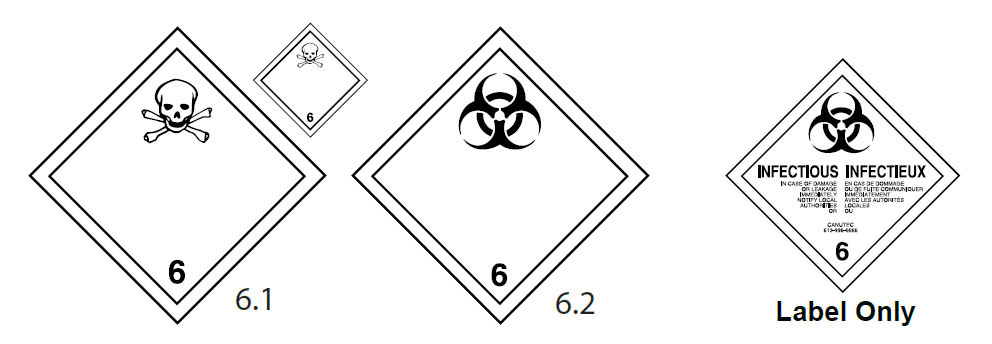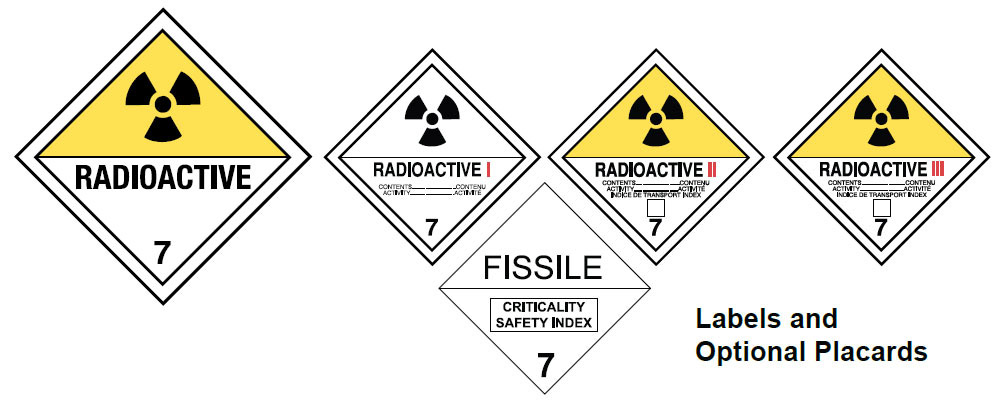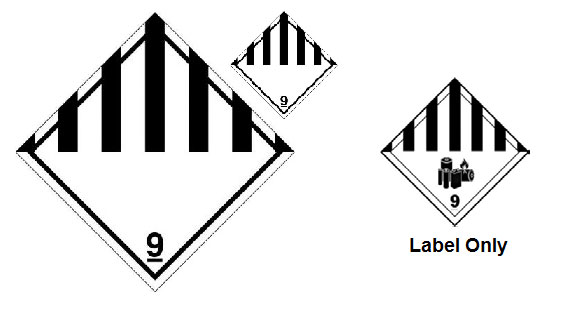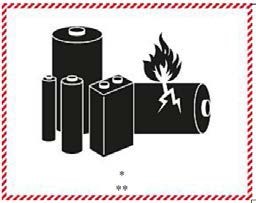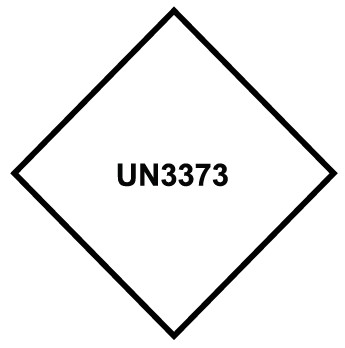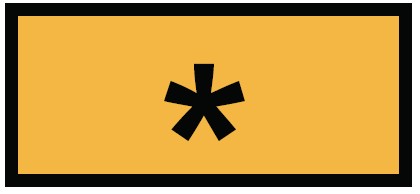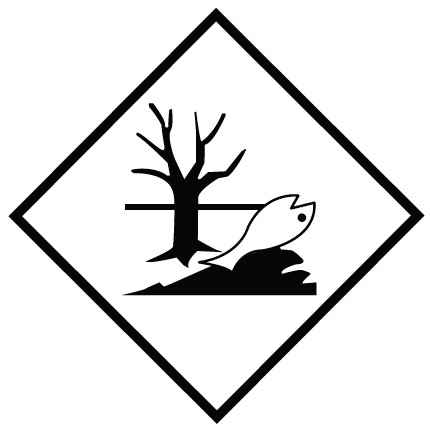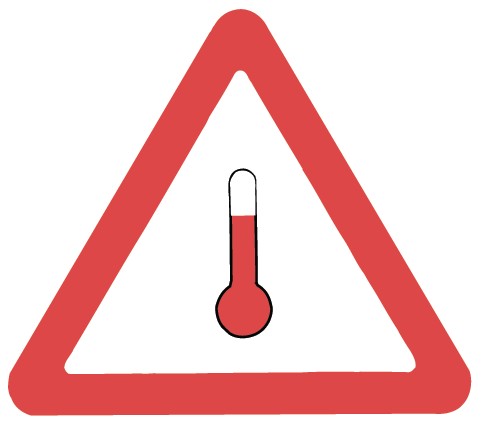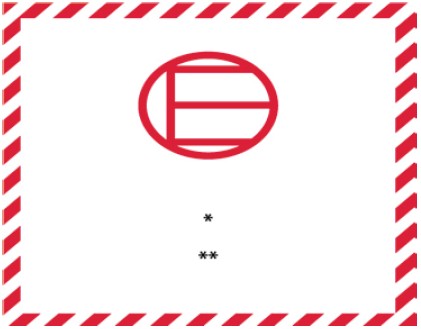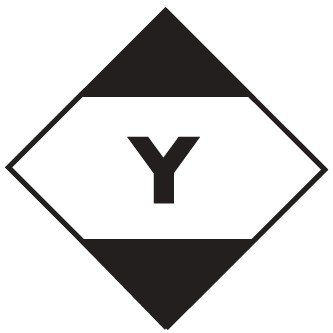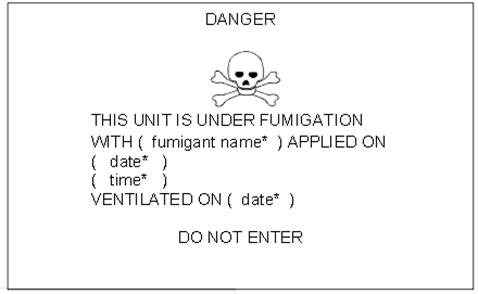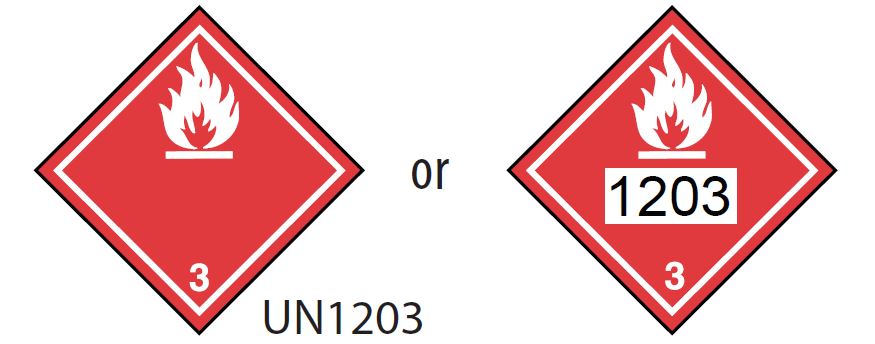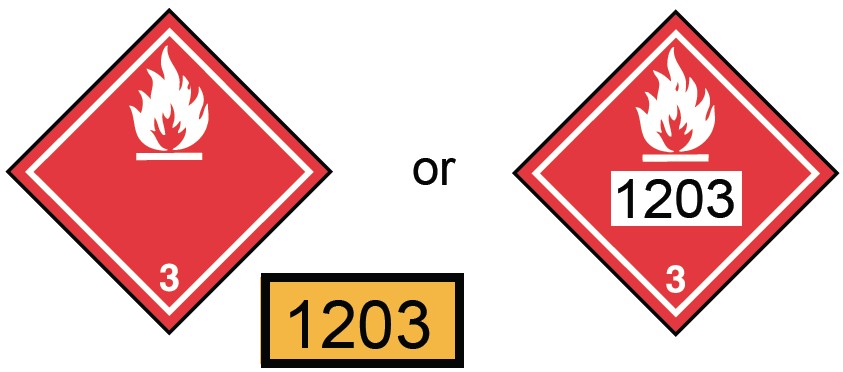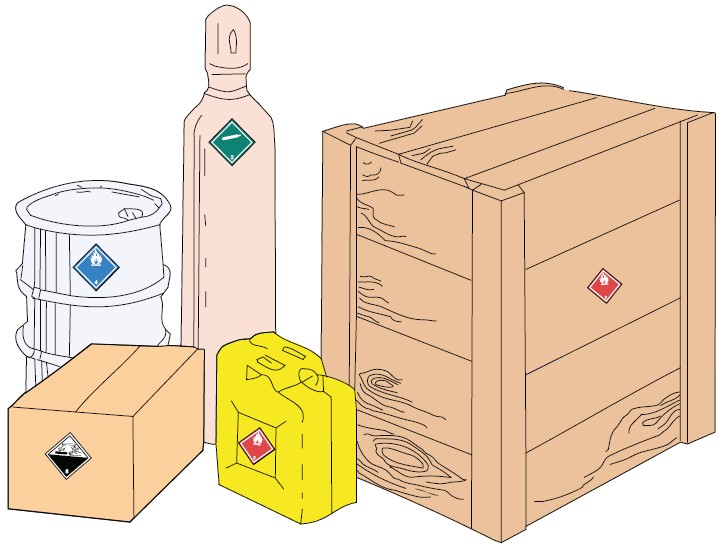CLASS 1 - Explosives
1.1 A substance or article with a mass explosion hazard.
1.2 A substance or article with a fragment projection hazard, but not a mass explosion hazard.
1.3 A substance or article which has a fire hazard along with either a minor blast hazard or a minor projection hazard or both, but not a mass explosion hazard.
1.4 A substance or article which presents no significant hazard; explosion effects are largely confined to the package and no projection or fragments of appreciable size or range are to be expected.
1.5 A very insensitive substance which nevertheless has a mass explosion hazard like those substances in 1.1.
1.6 An extremely insensitive article which does not have a mass explosion hazard.
Class 1: Group of images representing…
Top left image: Placard and label for Class 1.1, 1.2 and 1.3. Square on a point. Orange background. Starting from the bottom, the number 1, above it, * (asterisk) which corresponds to the Compatibility Group Letter and ** (double asterisk) for Division. Symbol of an exploding bomb in top portion. Identical, but smaller image directly beside larger image.
Top middle image: Placard and label for Class 1.4. Square on a point. Orange background. Starting from the bottom, the number 1, above it, * (asterisk) which corresponds to the Compatibility Group Letter. Number 1.4 in top portion. Identical, but smaller image directly beside larger image.
Right top image: Placard and label for Class 1.5. Square on a point. Orange background. Starting from the bottom, the number 1, above it, * (asterisk) which corresponds to the Compatibility Group Letter. Number 1.5 in top portion. Identical, but smaller image directly beside larger image.
Bottom image: Placard and label for Class 1.6. Square on a point. Orange background. Starting from the bottom, the number 1, above it, * (asterisk) which corresponds to the Compatibility Group Letter. Number 1.6 in top portion. Identical, but smaller image directly beside larger image.
CLASS 2 - Gases
2.1 Flammable Gases.
Commonly used as fuel (example: propane).
2.2 Non-Flammable, Non-Toxic Gases.
Commonly used in food refrigeration (example: nitrogen).
2.3 Toxic Gases.
Commonly used in pulp bleaching (example: sulphur dioxide).
2.2(5.1) Oxygen and oxidizing gases.
*Placard for UN1005, Anhydrous Ammonia only.
Class 2: Group of images representing…
Top left image: Placard and label for Class 2.1. Square on a point. Red background. Starting from the bottom, the number 2. Symbol of a flame in white in top portion. Identical, but smaller image directly beside larger image.
Top middle image: Placard and label for Class 2.2. Square on a point. Green background. Starting from the bottom, the number 2. Symbol of a gas cylinder in white in top portion. Identical, but smaller image directly beside larger image.
Top right image: Placard and label for Class 2.3. Square on a point. White background. Starting from the bottom, the number 2. Symbol of a skull and crossbones in top portion. Identical, but smaller image directly beside larger image.
Bottom left image: Placard for UN1005, Anhydrous Ammonia. Square on a point. White background. Starting from the bottom, the number 2, above it, the number 1005. Symbol of a gas cylinder in black in top portion.
Bottom right image: Placard and label for Oxidizing Gases. Square on a point. Yellow background. Starting from the bottom, the number 2. Symbol of a flame over a circle (flaming "O") in black in top portion. Identical, but smaller image directly beside larger image.
CLASS 3 - Flammable Liquids
A liquid which has a closed-cup flash point less than or equal to 60°C. Commonly used as fuel (example: gasoline, ethanol, fuel oil (diesel)).
Class 3: Image representing…
Left image: Placard and label for Class 9. Square on a point. White background with 7 black stripes in upper half. Starting from the bottom, the number 9. Identical, but smaller image directly beside larger image.
Right image: Label for Class 9 for lithium batteries. Square on a point. White background with 7 black stripes in upper half; battery group, one broken and emitting flame in lower half. Starting from the bottom, the number 9.
Placard and label for Class 3. Square on a point. Red background. Starting from the bottom, the number 3. Symbol of a flame in white in top portion. Identical, but smaller image directly beside larger image.
CLASS 4 - Flammable Solids, Substances liable to spontaneous combustion; Substances that on contact with water emit flammable gases (water-reactive substances)
4.1 A solid that under normal conditions of transport is readily combustible, or would cause or contribute to fire through friction or from heat retained from manufacturing or processing, or is a self-reactive substance that is liable to undergo a strongly exothermic reaction, or is a desensitized explosive that is liable to explode if not diluted sufficiently to suppress their explosive properties.
Commonly used in lacquers (example: naphthalene).
4.2 A substance liable to spontaneous combustion, under normal conditions of transport, or when in contact with air, liable to spontaneous heating to the point where it ignites.
Commonly used in rocket fuel (example: sodium hydrosulphite).
4.3 A substance that, on contact with water, emits dangerous quantities of flammable gases or becomes spontaneously combustible on contact with water or water vapour.
Commonly used in heat exchangers (valves) (example: sodium).
Class 4: Group of images representing…
Left image: Placard and label for Class 4.1. Square on a point. White background with 7 red stripes. Starting from the bottom, the number 4. Symbol of a flame in black in top portion. Identical, but smaller image directly beside larger image.
Middle image: Placard and label for Class 4.2. Square on a point. Upper half of background is white and lower half is red. Starting from the bottom, the number 4. Symbol of a flame in black in top portion. Identical, but smaller image directly beside larger image.
Right image: Placard and label for Class 4.3. Square on a point. Blue background. Starting from the bottom, the number 4. Symbol of a flame in white in top portion. Identical, but smaller image directly beside larger image.
CLASS 5 - Oxidizing Substances and Organic Peroxides
5.1 A substance which causes or contributes to the combustion of other material by yielding oxygen or other oxidizing substances whether or not the substance itself is combustible.
Commonly used in fertilizers (example: ammonium nitrate).
5.2 An organic compound that contains the bivalent “-O-O-” structure which is a strong oxidizing agent and may be liable to explosive decomposition, be sensitive to heat, shock or friction or react dangerously with other dangerous goods.
Commonly used in automobile body shops as body filler (example: dibenzoyl peroxide).
Class 5: Group of images representing…
Left image: Placard and label for Class 5.1. Square on a point. Yellow background. Starting from the bottom, the number 5.1. Symbol of a flame over a circle (flaming "O") in black in top portion. Identical, but smaller image directly beside larger image.
Right image: Placard and label for Class 5.2. Square on a point. Upper half of background is red and lower half is yellow. Starting from the bottom, the number 5.2. Symbol of a flame in black in top portion. Identical, but smaller image directly beside larger image.
CLASS 6 - Toxic Substances and Infectious Substances
6.1 A solid or liquid that is toxic through inhalation, by skin contact or by ingestion.
Commonly used as a germicide or general disinfectant (example: phenol).
6.2 Micro-organisms that are infectious or that are reasonably believed to be infectious to humans or animals.
Commonly used in disease research (example: rabies virus).
Class 6: Group of images representing…
Left image: Placard and label for Class 6.1. Square on a point. White background. Starting from the bottom, the number 6. Symbol of a skull and crossbones in top portion. Identical, but smaller image directly beside larger image.
Middle image: Placard for Class 6.2. Square on a point. White background. Starting from the bottom, the number 6. Symbol of three crescents superimposed on a circle in top portion.
Right image: Label for Class 6.2. Square on a point. White background. Starting from the bottom, the number 6, and above it, the following text: INFECTIOUS...IN CASE OF DAMAGE...OR LEAKAGE...IMMEDIATELY...NOTIFY...LOCAL AUTHORITIES...AND...CANUTEC...613-996-6666 (identical text in French). Symbol of three crescents superimposed on a circle in top portion.
CLASS 7 - Radioactive Materials
Substances defined as Class 7, Radioactive Materials in the Packaging and Transport of Nuclear Substances Regulations.
Commonly used in nuclear fuel rods (example: radioactive material - LSA (yellow cake)).
There are three categories which indicate the surface radiation level for a package with Category I being the lowest level and Category III the highest.
Class 7: Group of images representing…
Top left image: Placard for Class 7. Square on a point. Upper half of background (excluding border) is yellow and lower half and border is white. Starting from the bottom, the number 7, above this, the word RADIOACTIVE below the middle line. Symbol of a trefoil in top portion.
Top left middle image: Label for Class 7, Category I. Square on a point. White background. Starting from the bottom, the number 7, above this, the following text: ACTIVITY...CONTENTS (identical text in French). Above this, the word RADIOACTIVE followed by one vertical bar in red below the middle line. Symbol of a trefoil in top portion.
Top right middle image: Label for Class 7, Category II. Square on a point. Upper half of background (excluding border) is yellow and lower half and border is white. Starting from the bottom, the number 7, above this, a box, then the following text: TRANSPORT INDEX...ACTIVITY...CONTENTS (identical text in French). Above this, the word RADIOACTIVE followed by two vertical bars in red below the middle line. Symbol of a trefoil in top portion.
Top right image: Label for Class 7, Category III. Square on a point. Upper half of background (excluding border) is yellow and lower half and border is white. Starting from the bottom, the number 7, above this, a box, then the following text: TRANSPORT INDEX...ACTIVITY...CONTENTS (identical text in French). Above this, the word RADIOACTIVE followed by three vertical bars in red below the middle line. Symbol of a trefoil in top portion.
Bottom image: Label for Class 7, Fissile. Square on a point. White background. Starting from the bottom, the number 7, above this, the following text in a box: CRITICALITY SAFETY INDEX. Above this, the word FISSILE.
CLASS 8 - Corrosives
A substance that causes destruction of skin or corrodes steel or non-clad aluminum.
Commonly used in batteries and industrial cleaners (example: sulphuric acid and sodium hydroxide).
Class 8: Image representing…
Placard and label for Class 8. Square on a point. Upper half of background and border is white and lower half is black. Starting from the bottom, the number 8. Symbol of liquid spilling from two test tubes and attacking a hand and a metal bar in top portion. Identical, but smaller image directly beside larger image.
CLASS 9 - Miscellaneous Products, Substances or Organisms
A substance that does not meet the criteria for inclusion in Classes 1 to 8, but is nonetheless a dangerous good in transport. This includes marine pollutants (environmentally hazardous substances) and elevated temperature materials.
Examples are dry ice, asbestos and lithium batteries.
Class 9: Image representing…
Left image: Placard and label for Class 9. Square on a point. White background with 7 black stripes in upper half. Starting from the bottom, the number 9. Identical, but smaller image directly beside larger image.
Right image: Label for Class 9 for lithium batteries. Square on a point. White background with 7 black stripes in upper half; battery group, one broken and emitting flame in lower half. Starting from the bottom, the number 9.
Other Marks
Lithium Battery Mark. Rectangle with red hatching slanted to the right around edge. White background. Black symbol of a group of batteries, one damaged and emitting flame.
Lithium Battery Mark
Category B Mark. Square on a point. White background with UN3373 in the centre.
Mark for Category B
infectious substances, UN3373
Orange panel. Rectangle with orange background and black border. * (asterisk) in the middle which corresponds to the UN number.
Orange Panel
DANGER placard. Square on a point. Red background with white horizontal band in the centre with the word DANGER.
Mixed Load Shipment
Marine Pollutant Mark. Square on a point. White background with symbol of a dead fish and a tree in the centre.
Marine Pollutant Mark
Elevated Temperature Sign. Equilateral triangle with red border and white background. Symbol of red thermometer in the centre.
Elevated Temperature Sign
Excepted Quantities Mark. Square with red hatching slanted to the right around edge. White background. Starting from the bottom, ** (double asterisk), which corresponds to the name of the consignor or the consignee, above it, * (asterisk) for the primary class. Symbol of a red stylized capital E in a circle.
Excepted Quantities Mark
Limited Quantities Mark. Square on point. Top and bottom portions are black with white background.
Limited Quantities Mark
Limited Quantities Mark in compliance with the ICAO Technical Instructions. Square on point. Top and bottom portions are black with white background. Black letter Y in centre of mark.
Limited Quantities Mark
(ICAO Technical Instructions)
Fumigation Sign
Fumigation Sign. Rectangle with white background. Symbol of one skull and crossbones in top center of the rectangle with the word DANGER on top of it. Below this, the following text: This unit is under fumigation... with (fumigant name)... Applied on...(date)...(time)... Ventilated on (Date). The words DO NOT ENTER are displayed at the bottom of the rectangle and centered (identical text in French).
Display of UN number on small means of containment.
Left image: Square on a point. Red background. Starting from the bottom, the number 3. Symbol of a flame in white in top portion. Beside image on right, the text UN1203.
Right image: Square on a point. Red background. Starting from the bottom, the number 1203 in a white rectangle. Symbol of a flame in white in top portion.
Small Means
of Containment
Display of UN number on small means of containment.
Left image: Square on a point. Red background. Starting from the bottom, the number 3. Symbol of a flame in white in top portion. Beside image on right, the text UN1203.
Right image: Square on a point. Red background. Starting from the bottom, the number 3, the number 1203 in a white rectangle. Symbol of a flame in white in top portion.
Large Means
of Containment
Display of placards on a large means of containment (truck).
Left image: Front of truck with DANGER placard in the middle.
Middle image: Side of truck with DANGER placard in the middle.
Right image: Back of truck with DANGER placard on lower left side.
Side of rail tank car with Class 3 placard on lower right hand side.
Back of rail tank car with Class 3 placard on lower right hand side.
Small means of containment with labels, which includes a drum, a box, a cylinder, a jerrican and a crate.
In Case of Emergency
CANUTEC
(Call Collect 24 hours)
(613) 996-6666
* 666 for cellular phones (in Canada only)
TP 11504 - The Marks of Safety
(PDF, 933 KB)


